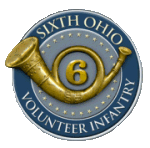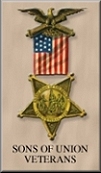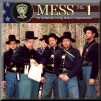


















CHICKAMAUGA
Following the heavy fighting at Stones River, the Army of the Cumberland went into winter quarters at Murfreesboro. The 6th Ohio, like many other regiments in the army, had suffered significant casualties and required time to heal up their wounded, reorganize, and refit their ranks. Colonel Anderson returned to the regiment in March after recovering from his painful wound at Stones River. No significant action took place for the army until late spring when preparations began for a movement against the Confederate army near Tullahoma. On June 24th, 1863, the army stepped off, heading south to find Bragg.
Over the next several months, the 6th Ohio experienced hard marching but very little in the way of fighting. However, as Bragg's forces moved back toward northern Georgia, skirmishing and maneuvering increased in intensity until the two armies came to blows at the fierce Battle of Chickamauga on September 19th and 20th. The 6th Ohio was actively engaged in the fight, losing 12 killed, 6 mortally wounded, 76 wounded and 16 missing for a total of 110 casualties out of the 345 in the regiment. Once again, Colonel Anderson was severely wounded, this time by a musket ball in the shoulder.




HISTORY OF THE SIXTH OHIO
The Sixth Ohio served at many battles in the Western Theater during the Civil War, including Shiloh, Stone's River, Chickamauga and Chattanooga. For more about the Sixth's service during the war, read on:


Web Site is the Property of the Sixth Ohio Volunteer Infantry. All Rights Reserved, 2020.




ORGANIZATION
The 6th Ohio regiment was first organized in Cincinnati for 90-day service in late April, 1861, and began its training at Camp Harrison near downtown. The regiment was made up primarily of men from Hamilton County, with some additional recruits coming from Butler and Warren counties and Northern Kentucky. Companies A and B were formed from members of a local militia organization know as the Guthrie Greys.
In late May, the regiment was moved to Camp Dennison to continue its preparation for service. The camp, named after Governor William Dennison, was one of the largest training and recruitment depots used by the Union Army during the war, with over 100,000 troops passing through it during the four years of the war. On June 18th, the 6th Ohio Volunteer Infantry mustered into 3-year service with a strength of 1,016 enlisted men and officers. They were commanded by Col. William K. Bosley at this time. Lt. Colonel Nicholas L. Anderson was second in command.
On June 30, 1861, the 6th Ohio left Camp Dennison on route to West Virginia, where over the next several months they were involved in active campaigning at Grafton, Carricks Ford, Beverly and Cheat Mountain. In November, the regiment became part the Army of the Ohio under the command of Major General Don Carlos Buell. After spending winter quarters at Camp Wickliffe, Kentucky, south of Louisville, the army moved south in mid February to occupy Nashville, Tennessee. The 4th Division was the first to reach Nashville, and the 6th Ohio the first regiment of the division in the city. The regimental colors were immediately placed atop the courthouse. Nashville was the first Confederate state capital to fall into Union hands.
SHILOH
In March of 1862, Buell's army marched south from Nashville to begin a link up with General Grant's Army of the Tennessee, which was advancing against Confederates forces under General Albert Sidney Johnston in Northern Mississippi. In late March, Grant's forces halted and camped at Pittsburg Landing on the west bank of the Tennessee River about 20 miles north of Corinth, Mississippi, as preparations continued for a leap at the rebels. After more than a week of marching into western Tennessee, the Army of the Ohio set up camp in Savannah on April 5th. On the morning of April 6th, Grant's army was surprised and attacked in their camps at Pittsburg Landing, near a modest pioneer chapel known as Shiloh Church. Buell's army was ordered to move at once to the battlefield, some 20 miles away on the opposite bank of the river. The 6th Ohio was part of Jacob Ammen's 10th Brigade in General William "Bull" Nelson's 4th division.
The regiment was in the van of the march along the east bank of the river leading to a crossing at Pittsburg Landing. They reached the bank opposite the battlefield on the evening of April 6th and crossed with the division via transports, taking up a position on the far left of Grant's army in time to help check the final Rebel assault of the day. Throughout the night, the Army of the Ohio filed onto the field and reinforced Grant's army. With Buell's men on the field, Grant was prepared to advance at first light and counter the Confederate advance of the previous day.
On the second day of fighting at Shiloh, the 6th Ohio moved steadily forward on the left as the combined Union armies fought over the corpse-strewn ground that had been captured by Confederates the prior day. Company A of the 6th Ohio was called to man artillery pieces in Terrill's battery, whose crews had been decimated in the earlier fighting. The Union forces drove the Confederates steadily back and, by late afternoon on April 7th, completely off the battlefield. Thus ended the bloody Battle of Shiloh. During the battle, the two sides suffered over 23,000 casualties.
The 6th Ohio's final position was near the Bloody Pond, nearly two miles from where their battle line was formed after coming across the river. In the fighting the regiment lost 2 killed, 5 wounded and 1 missing. They had been led into battle by 23-year old Lt. Col. Anderson who had take command due to the illness of Col. Bosley. It was their first severe test and the regiment had performed admirably.

STONE'S RIVER
On December 26th, Rosecrans left Nashville with about 45,000 men, to defeat Bragg's army. He found the rebels on December 29 and went into camp that night within hearing distance of the enemy. At dawn on the 31st, Bragg's men attacked the Union right flank. Heavy fighting ensued and the 6th Ohio fought desperately among the cedar thickets and woods, suffering many casualties along the way. The Confederates drove the Union line back to the Nashville Pike, but a staunch defense held there. The 6th Ohio took part in heavy fighting in this defensive stand. Union reinforcements arrived from Rosecran's left in the late forenoon to bolster the stand and before fighting stopped that day, the Federals had established a new, strong line.
On New Years Day, there was lull in the fighting. Bragg surmised that Rosecrans would now withdraw, but the next morning he was still in position. In late afternoon, on January 2nd, the battle resumed. The Confederates drove the Federals back, but, with the help of artillery, the Federals repulsed the attack. Bragg left the field on the January 4-5, retreating to Shelbyville and Tullahoma, Tennessee. Rosecrans did not pursue, but as the Confederates retired, he claimed the victory. Stones River boosted Union morale. The 6th Ohio fought valiantly and suffered its heaviest losses of the war. The regiment had 24 killed, 19 mortally wounded, 108 wounded (including Colonel Anderson), and 12 missing.
CHATTANOOGA
After the battle, the army fell back to their lines at Chattanooga, Tennessee. It was there that Union forces came under siege from the Confederates converging to clamp the Union army in position. In late October, with the shutting up of the army at Chattanooga, the scarcity of rations became a severe test of endurance for both officers and men. The affair known as the Battle of Browns Ferry, was fought by picked men from the brigades of Hazen and Turchin, which the 6th Ohio furnished it due portion of men. This battle opened up what is known as the "Cracker Line" and supplies were then made available for the besieged troops of Chattanooga.
In mid-November, General Grant moved to reinforce Chattanooga and break the siege. Operations commenced in front of Chattanooga in late November and the 6th Ohio was in the advance upon Orchard Knob on the 23rd, and in the charge up Missionary Ridge on the 25th. During the fighting at Chattanooga, the 6th Ohio lost 33 out of a total of 265 officers and men.
With Chattanooga securely in Union hands, the gateway to the deep south was open as a base of supplies for a spring campaign by Sherman. After a difficult winter spent maneuvering and securing areas around Knoxville in eastern Tennessee, the 6th Ohio advanced toward Atlanta with Sherman's army beginning in May of 1864.
GOING HOME
With just a short time remaining on their 3-year enlistments, the men of the 6th Ohio were eager to end their service and return home. On June 6, 1864, at the Battle of Resaca, the regiment was assigned to guard a railroad bridge over the Oostenaula River. Following the battle, the 6th OVI was released from duty and ordered home. Nine days later, the regiment arrived at Cincinnati and was mustered out of service on June 23, 1864 at Camp Dennison.


Surviving members of the Guthrie Greys, Sixth Ohio Volunteer Infantry honor their old commander, Colonel Nicholas Longworth Anderson by unveiling a bronze tablet at his grave in Spring Grove Cemetery.

HARD CAMPAIGNING
Following Shiloh, the Army of the Ohio moved south and pressed slowly forward toward Corinth, where the Confederate army had retreated. The regiment participated in skirmishing and picket duties along the route, the eventual siege of Corinth, and the continued pursuit of the retreating enemy through mid-July. On July 13th, General Forrest's rebel cavalry captured the Federal garrison at Murfreesboro, Tennessee. As a result, Nelson's division was ordered to move by rail to Nashville and then on to Murfreesboro to re-establish communication with that place. Once having secured the city, the division was ordered McMinnville, Tennessee, where it would remain within supporting distance of the army. The 6th Ohio was placed on picket duty and quartered in the town.
In August 1862, Buell's army moved to Louisville, Kentucky to counter a movement into the state by General Braxton Bragg's army as an effort to claim it for the Confederacy and muster new recruits for the army. In September, his Army of the Ohio came out of its works in Louisville and forced Bragg back into central Kentucky. On October 8th, 1862, the two armies met at the Battle of Perryville. The 6th Ohio was part of Crittenden's 2nd Corps but did not take an active part in the fighting there, except to assist in securing the town after the battle and pursuing the retreating army for some distance. Shortly after the battle, Buell was replaced as Union commander by Major General William Rosecrans. His new command was soon renamed the Army of the Cumberland. Rosecran's army moved south once again, following the rebels into Tennessee, where Bragg's Confederates were preparing to go into winter quarters at Murfreesboro. The Union army encamped at Nashville.
September 13, 2020






